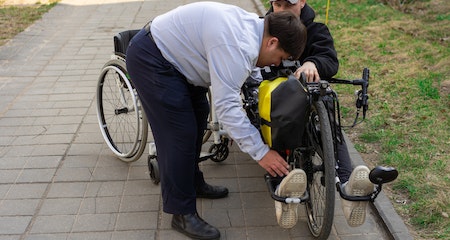There are several different types of disability. These include brain injury, learning disability, and physical disability. Each type has its own unique characteristics, but there are some common ones. Here, we’ll discuss some of the most common ones and how they are classified. If you have a disability, it’s important to seek help. It’s also important to understand your rights as a disabled person. Disability is not a sign of weakness; it is a way to express your unique needs.
Brain injury
A traumatic brain injury is a kind of disability that results in permanent or severe damage to a person’s brain. This type of injury causes a variety of symptoms, some of which appear immediately after an accident, while others take months or even years to manifest. A person suffering from a traumatic brain injury must submit to a Social Security disability care brisbane evaluation, otherwise known as a ‘Blue Book’ evaluation. During this evaluation, the Social Security Administration compares your diagnosis against the ‘Blue Book’ list of conditions and impairments.
People who have suffered a traumatic brain injury often experience difficulty with communication and social functioning. They can have problems reading nonverbal cues, following conversations, and sleeping. These symptoms can last for months or even years, and they can also make it difficult to perform simple tasks. These symptoms can have a negative impact on a person’s ability to function in daily life and can prevent them from working.
A traumatic brain injury causes a variety of melbourne disabilities care , including those affecting their thinking, their five senses, their physical ability to communicate, and their mental health. It affects every aspect of a person’s life. It can also cause a condition known as Postconcussion Syndrome, which results in feelings of agitation, depression, and sleep disturbance. These symptoms are usually treatable with medication and occupational therapy. A person may also need time off work to overcome these symptoms.
A TBI also results in emotional and behavioral problems. These problems are often difficult for family members to deal with. These issues can include problems with short and long-term memory, and may cause the patient to become inattentive, aggressive, or socially inappropriate. Further, the effects of TBI can lead to other problems, such as difficulty learning new things and focusing attention.
There are many different types of brain injury. There are two types: acquired and congenital. Acquired brain injury is damage to the brain that occurs after birth. These injuries are often classified differently than congenital disabilities. A stroke is caused by a blockage of blood vessels, while an infection can inflame the brain tissue.
Psychiatric disability
Psychiatric disability is a common challenge that many individuals face. Having a mental illness can make it difficult to maintain a job. The unemployment rate for people with a mental disability is more than twice that of the able-bodied population. However, work is an important part of one’s life as it provides a sense of purpose and motivation. In addition, work can demonstrate one’s skills and talents. Having a job has been shown to improve one’s self-esteem, and work has been proven to enable people with mental illness to actively participate in development.
Psychiatric disabilities include mood and anxiety disorders. Anxiety disorders include excessive worrying or fear, which interferes with daily activities. Examples of anxiety disorders include phobias, panic disorders, post-traumatic stress disorder, and obsessive-compulsive disorder. Mood disorders, on the other hand, often affect a person’s mood and behavior, such as bipolar disorder and seasonal affective disorder.
The World Health Organization estimates that one in four people suffers from a mental health disorder. This makes psychiatric disability one of the most common forms of disability in the world. As such, it’s important to recognize the differences between these conditions and understand how they affect a person’s life.
Despite the stigma associated with mental health conditions, there is no reason for employers to exclude a person with a mental illness from the workplace. Many workers with psychiatric disabilities are capable of recovering from their problems and working in a demanding and stressful job environment. Furthermore, they don’t pose a danger to themselves or others.
People with psychiatric disabilities have two basic rights under the ADA. First, they have the right to privacy. They can choose whether to disclose their disability. Second, they can request reasonable job accommodations. In addition, they are entitled to receive assistance that helps them achieve the best quality of life.
If you or a loved one suffers from a mental illness, you may be eligible to receive Social Security disability benefits. A psychiatrist can assist in filing a disability claim.
Physical disability
Physical disability is a form of disability that affects a person’s ability to move and perform physical tasks. It can be a result of an inherited disorder, a serious medical condition, or an injury. It may also be caused by a brain injury. Those with this disability may have trouble walking, grasping things, or even thinking clearly.
Physical disability affects the joints, bones, and muscles of a person, making it difficult to move these parts of the body. There are more than 200 different musculoskeletal conditions in the United Kingdom, and about 20 per cent of people visit a doctor each year for a musculoskeletal problem. Among the more common types of musculoskeletal disabilities are back pain and osteoarthritis. Inflammatory conditions, such as rheumatoid arthritis, can also result in physical disability. Another type of disability is a neuromusculoskeletal disability, which results from a disorder of the nervous system.
A person who is suffering from physical disability may experience special stresses due to their particular situation. For example, they may not be able to work or support themselves financially. They may also need total care and assistance with everyday activities. In severe cases, the person may need to use a wheelchair.
Physical disabilities have many causes and can range from congenital disorders to accidents and diseases. It is important to understand the causes of physical disability and how to best treat people with disabilities. In general, physical disabilities can have a positive or negative impact on a person’s life. Therefore, it is imperative to provide the necessary support to help them achieve their full potential.
Physical disabilities can affect a person’s ability to learn in the classroom. There are various accommodations that can help meet the educational needs of people with disabilities. Invisible disabilities may include mental illness, blindness, and dizziness. Invisible disabilities can also affect learning and cognitive functions.
Another form of physical disability is a brain injury. A brain injury, also known as acquired brain injury (ABI), can impair one’s ability to walk or talk. Fortunately, it is not permanent, and in most cases, a person can recover. But, some symptoms may remain and may require a wheelchair or walking crutches.
Learning disability
Learning disabilities can interfere with a person’s ability to learn and use specific skills. These disabilities are often genetic or neurobiological in origin. They interfere with basic skills and higher-level cognitive skills such as language, organization, and time management. They can also affect relationships. People with learning disabilities often exhibit other symptoms such as difficulty controlling behavior and hyperactivity.
Learning disabilities can be mild, moderate, or severe. The severity of a learning disability will determine how much support a person needs to complete day-to-day tasks. In severe cases, a person may require full-time care and assistance in every aspect of their life. Learning disabilities are also common in people with Down’s syndrome and some types of autism. It’s important to note that learning disabilities are not the same as dyslexia. People with dyslexia have similar difficulties but are not intellectually impaired.
A learning disability can affect any academic discipline. Although there is no specific definition of what is a learning disability, many studies label specific groups of students as having the condition. Increasing evidence shows that the presence of learning disabilities is linked with poor performance in other areas of life. In addition, students with learning disabilities typically have lower achievement levels than their peers.
A child with a learning disability has difficulty processing information and learning new skills. While the disability itself is rare, it’s often associated with a low self-esteem and other psychological problems. Learning disabilities are the result of an unknown factor affecting the functioning of the brain. Without intervention, these conditions can worsen, resulting in a low self-esteem and increased levels of anxiety and depression in a child.
Learning disabilities also affect motor skills, speech and language, and visual perception. Those with a learning disability can have difficulty understanding spoken language, interpreting visual information, and distinguishing between different sounds. Learning disability also impacts motor skills, including fine and gross motor skills. When combined with visual and auditory impairments, these problems can interfere with a person’s ability to understand words and comprehend basic concepts of reading.
A learning disability can be diagnosed by a variety of professionals. These professionals use a combination of tests that assess the cognitive ability of the person. These tests may include intelligence tests, academic achievement tests, social interaction, and aptitude tests. The DSM-IV also considers the disorder as one type of disability.









